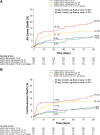Angiographic Characteristics and Clinical Outcomes in Patients With Chronic Kidney Disease Undergoing Impella-Supported High-Risk Percutaneous Coronary Intervention: Insights From the cVAD PROTECT III Study
- PMID: 38708609
- PMCID: PMC11239095
- DOI: 10.1161/CIRCINTERVENTIONS.123.013503
Angiographic Characteristics and Clinical Outcomes in Patients With Chronic Kidney Disease Undergoing Impella-Supported High-Risk Percutaneous Coronary Intervention: Insights From the cVAD PROTECT III Study
Abstract
Background: Prior studies have found that patients with chronic kidney disease (CKD) have worse outcomes following percutaneous coronary intervention (PCI). There are no data about patients with advanced CKD undergoing Impella-supported high-risk PCI. We, therefore, aimed to evaluate angiographic characteristics and clinical outcomes in patients with CKD who received Impella-supported high-risk PCI as part of the catheter-based ventricular assist device PROTECT III study (A Prospective, Multi-Center, Randomized Controlled Trial of the IMPELLA RECOVER LP 2.5 System Versus Intra Aortic Balloon Pump [IABP] in Patients Undergoing Non Emergent High Risk PCI).
Methods: Patients enrolled in the PROTECT III study were analyzed according to their baseline estimated glomerular filtration rate (eGFR). The primary outcome was 90-day major adverse cardiovascular and cerebrovascular events (the composite of all-cause death, myocardial infarction, stroke/transient ischemic attack, and repeat revascularization).
Results: Of 1237 enrolled patients, 1052 patients with complete eGFR baseline assessment were evaluated: 586 with eGFR ≥60 mL/min per 1.73 m2, 190 with eGFR ≥45 to <60, 105 with eGFR ≥30 to <45, and 171 with eGFR <30 or on dialysis. Patients with lower eGFR (all groups with eGFR <60) were more frequently females and had a higher prevalence of hypertension, diabetes, anemia, and peripheral artery disease. The baseline Synergy Between PCI With Taxus and Cardiac Surgery score was similar between groups (28.2±12.6 for all groups). Patients with lower eGFR were more likely to have severe coronary calcifications and higher usage of atherectomy. There were no differences in individual PCI-related coronary complications between groups, but the rates of overall PCI complications were less frequent among patients with lower eGFR. Major adverse cardiovascular and cerebrovascular events at 90 days and 1-year mortality were significantly higher among patients with eGFR <30 mL/min per 1.73 m2 or on dialysis.
Conclusions: Patients with advanced CKD undergoing Impella-assisted high-risk PCI tend to have higher baseline comorbidities, severe coronary calcification, and higher atherectomy usage, yet CKD was not associated with a higher rate of immediate PCI-related complications. However, 90-day major adverse cardiovascular and cerebrovascular events and 1-year mortality were significantly higher among patients with eGFR<30 mL/min per 1.73 m2 or on dialysis. Future studies of strategies to improve intermediate and long-term outcomes of these high-risk patients are warranted.
Registration: URL: https://www.clinicaltrials.gov; Unique identifier: NCT04136392.
Keywords: coronary artery disease; glomerular filtration rate; hypertension; percutaneous coronary intervention; renal insufficiency, chronic.
Conflict of interest statement
Dr Bharadwaj reports consulting and speaker fees from Abiomed, Shockwave Medical, and Cardiovascular Systems, Inc. Dr Batchelor reports consulting for Abbott, Medtronic, and Boston Scientific. Dr Grines reports participation on the advisory boards for Philips and Abiomed. Dr Baron reports receiving institutional research support from Boston Scientific Corporation, Acarix, and Abiomed; speaker fees from Medtronic, Edwards Lifesciences, Shockwave, and Zoll Medical; and consulting fees/advisory board membership from Medtronic, Boston Scientific Corporation, Zoll Medical, and Abiomed. Dr Redfors reports consultant fees from Pfizer and Boehringer Ingelheim. Dr Lansky received speaker fees from Abiomed. M.B. Basir has been a consultant/speaker for Abiomed, Boston Scientific, Chiesi, Saranas, and Zoll. Dr O’Neill reports grant/research support from St. Jude Medical, Edwards Life Sciences, and Biomed; consulting fees/honoraria from Medtronic and Abiomed; and major stock shareholder/equity in Synecor, Accumed, Neovasc, Tendyne, and Mitral Align. The other authors report no conflicts.
Figures




Similar articles
-
Characteristics and Outcomes of Older Patients Undergoing Protected Percutaneous Coronary Intervention With Impella.J Am Heart Assoc. 2025 May 6;14(9):e038509. doi: 10.1161/JAHA.124.038509. Epub 2025 Apr 16. J Am Heart Assoc. 2025. PMID: 40240978 Free PMC article. Clinical Trial.
-
Prophylactic use of intra-aortic balloon pump for high-risk percutaneous coronary intervention: will the Impella LP 2.5 device show superiority in a clinical randomized study?Cardiovasc Revasc Med. 2010 Apr-Jun;11(2):91-7. doi: 10.1016/j.carrev.2009.07.006. Cardiovasc Revasc Med. 2010. PMID: 20347798
-
Outcomes among patients with coronary bifurcation lesions undergoing Impella-supported high-risk percutaneous coronary intervention.Am Heart J. 2025 Dec;290:6-16. doi: 10.1016/j.ahj.2025.05.013. Epub 2025 May 22. Am Heart J. 2025. PMID: 40412495
-
Comparison of Coronary Artery Bypass Grafting and Drug-Eluting Stents in Patients with Left Main Coronary Artery Disease and Chronic Kidney Disease: A Systematic Review and Meta-Analysis.Cardiovasc Revasc Med. 2019 Dec;20(12):1184-1189. doi: 10.1016/j.carrev.2019.01.018. Epub 2019 Mar 3. Cardiovasc Revasc Med. 2019. PMID: 30842042
-
Myocardial revascularization in patients with chronic kidney disease: a systematic review and meta-analysis of surgical versus percutaneous coronary revascularization.Interdiscip Cardiovasc Thorac Surg. 2025 Mar 5;40(3):ivaf021. doi: 10.1093/icvts/ivaf021. Interdiscip Cardiovasc Thorac Surg. 2025. PMID: 39969961 Free PMC article.
Cited by
-
Impact of Diabetes on Long-Term Outcomes of Percutaneous Coronary Intervention for Coronary Bifurcation Lesions.Catheter Cardiovasc Interv. 2025 Aug;106(2):743-751. doi: 10.1002/ccd.31476. Epub 2025 Mar 5. Catheter Cardiovasc Interv. 2025. PMID: 40045508 Free PMC article.
References
-
- Sarnak MJ, Amann K, Bangalore S, Cavalcante JL, Charytan DM, Craig JC, Gill JS, Hlatky MA, Jardine AG, Landmesser U, et al. ; Conference Participants. Chronic kidney disease and coronary artery disease: JACC state-of-the-art review. J Am Coll Cardiol. 2019;74:1823–1838. doi: 10.1016/j.jacc.2019.08.1017 - PubMed
-
- Bundy JD, Chen J, Yang W, Budoff M, Go AS, Grunwald JE, Kallem RR, Post WS, Reilly MP, Ricardo AC, et al. . Risk factors for progression of coronary artery calcification in patients with chronic kidney disease: the CRIC study. Atheroscler. 2018;271:53–60. doi: 10.1016/j.atherosclerosis.2018.02.009 - PMC - PubMed
-
- Coca SG, Krumholz HM, Garg AX, Parikh CR. Underrepresentation of renal disease in randomized controlled trials of cardiovascular disease. JAMA. 2006;296:1377–1384. doi: 10.1001/jama.296.11.1377 - PubMed
-
- Smilowitz NR, Gupta N, Guo Y, Mauricio R, Bangalore S. Management and outcomes of acute myocardial infarction in patients with chronic kidney disease. Int J Cardiol. 2017;227:1–7. doi: 10.1016/j.ijcard.2016.11.026 - PubMed
Publication types
MeSH terms
Associated data
Grants and funding
LinkOut - more resources
Full Text Sources
Medical
Research Materials
Miscellaneous

